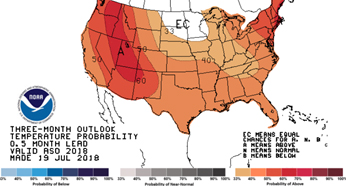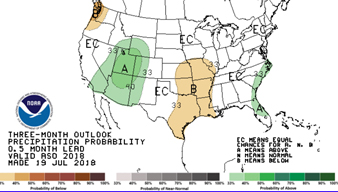Corn
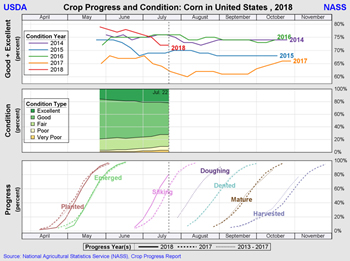 Corn continues to be ahead of schedule, with 91 percent silking and 38 percent in dough stage as of July 29, compared with 82 and 20 percent on average.
Corn continues to be ahead of schedule, with 91 percent silking and 38 percent in dough stage as of July 29, compared with 82 and 20 percent on average.
The condition is unchanged at 9 percent poor/very poor and 72 percent good/excellent, according to USDA. As the graph below shows, 2018 remains below 2014 and 2016 and if it follows their pattern, the top two categories could go either way from here. In 2014 and 2016, crop condition worsened a bit through August, while 2015 actually saw a modest improvement before sliding lower. In 2017, on the other hand, crop condition dropped and then recovered five points by harvesttime.
Soybeans
Beans in the 18 reporting states are still well ahead of normal in both blooming and setting pods, at 86 percent and 60 percent, respectively, compared with averages of 77 percent and 41 percent. All the states in our service area also are ahead of average.
Condition, right at 70 percent good/excellent in the 18 states, is a few points behind 2014 and 2016. But soybeans tend not to show large variations in condition from this point forward; based on the past four years, it is more likely to trend sideward. with small weekly adjustments, or even improve slightly.
Grain sorghum
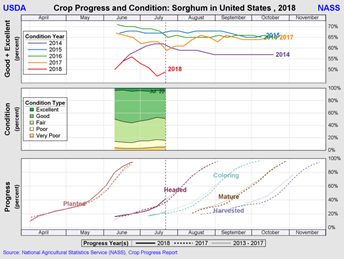 Although the top categories of condition saw a three-point bump up this week to 52 percent, sorghum is faring poorly compared with other crops. Seventy-eight percent of Nebraska’s crop is rated good/excellent, with only 1 percent poor/very poor. South Dakota follows with 78 and 1 percent; and Kansas, 63 percent and 5 percent.
Although the top categories of condition saw a three-point bump up this week to 52 percent, sorghum is faring poorly compared with other crops. Seventy-eight percent of Nebraska’s crop is rated good/excellent, with only 1 percent poor/very poor. South Dakota follows with 78 and 1 percent; and Kansas, 63 percent and 5 percent.
Sorghum is closer to average in progress: 4 percentage points more than average are headed while coloring is one point behind average.
Wheat
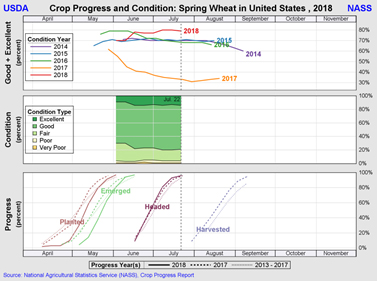 Winter wheat harvest is over in Kansas, 89 percent complete in Nebraska and 79 percent complete in South Dakota (where, on average, it is only 57 percent complete by this time). The average for the 18 reporting states is 85 percent, one point short of average.
Winter wheat harvest is over in Kansas, 89 percent complete in Nebraska and 79 percent complete in South Dakota (where, on average, it is only 57 percent complete by this time). The average for the 18 reporting states is 85 percent, one point short of average.
Spring wheat harvest already is 35 percent finished in South Dakota, against an average of 21 percent. In the six reporting states, it has reached its average level of 4 percent. Condition is rated at 78 percent good/excellent, down one point from a week ago but still well above 2014 to 2016. South Dakota’s crop is the worst listed, at 52 percent good/excellent and 10 percent poor/very poor.
Pasture
A look at USDA’s graph of grass condition shows continued long-term deterioration. Just 41 percent is measured as good/excellent while 29 percent falls into the bottom two categories. Kansas pasture/range is worse than the average for the 48 states, at 29 percent in the top categories and 35 in the bottom. South Dakota is rated 54 percent good/excellent and just 10 percent poor/very poor, while Nebraska continues to beat the averages by a wide margin, 71 percent good/excellent and just 8 percent poor/very poor.
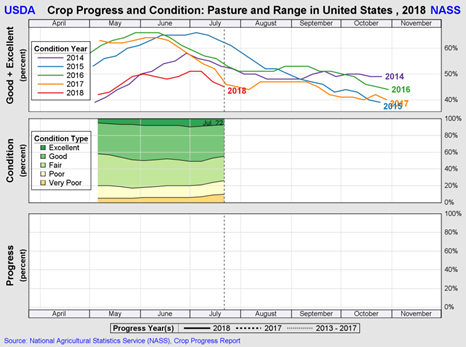
Looking ahead
The Climate Prediction Center’s outlook for the remainder of the growing season is for above average temperatures. Precipitation favors below normal from the Texas Gulf through eastern Kansas and Missouri, while the remainder of the Corn Belt has equal chances for above or below normal rainfall.
